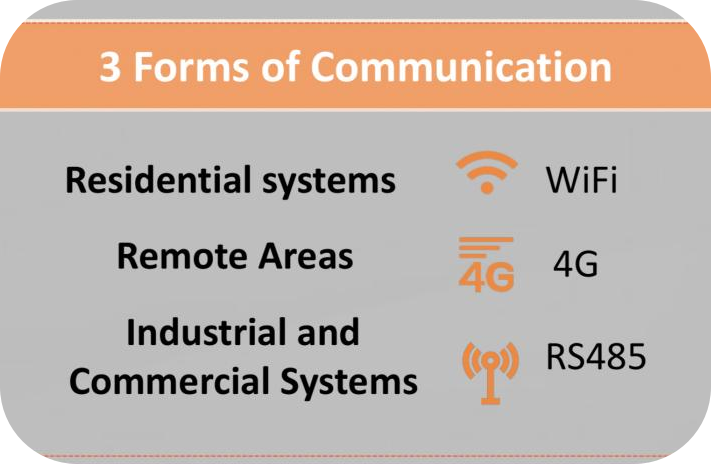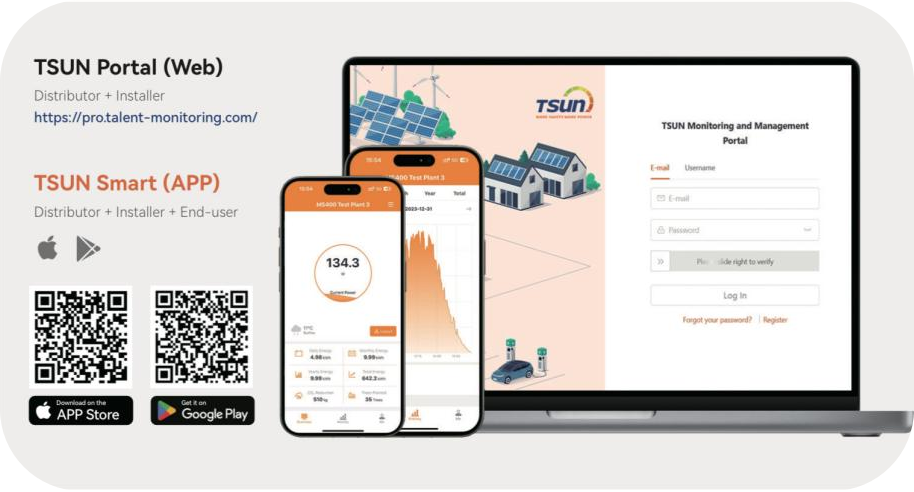Today, with the rapid development of solar photovoltaic technology, microinverters, as an innovative microinverter solution, are changing the way we use solar energy to generate electricity. Not only do they increase system efficiency, they also provide unprecedented monitoring and installation convenience. Understanding microinverters is crucial for anyone looking to invest in a solar solution, as they can significantly impact the performance and cost-effectiveness of the system.
Overview
A microinverter is a small but powerful photovoltaic device that converts direct current (DC) generated by solar panels into alternating current (AC) that can be used in homes and businesses. Unlike traditional string inverters, microinverters are typically connected to a single or a handful of solar panels, providing a more modular and efficient energy solution. With the large-scale application of photovoltaics, microinverters are increasingly important because of their ability to improve the overall system power generation efficiency, especially under partial shading or different solar radiation conditions.
Importance
Microinverters can not only improve photovoltaic power generation efficiency, but also provide more accurate system monitoring and maintenance capabilities. In addition, the microinverter design makes solar system installation more flexible and can be adapted to a variety of roof shapes and sizes. Moreover, based on the unique plug-and-play advantage of microinverters, it has promoted the rapid development of balcony photovoltaics in the industry. Therefore, whether you want to save more on electricity bills, reduce installation costs, or save energy and contribute to the environment, microinverters are one of the key technologies to achieve these goals.
1. What is a microinverter?
A microinverter is a small inverter that is connected to a single solar panel or a few solar panels to convert direct current (DC) into alternating current (AC). Unlike traditional string inverters, microinverters provide independent control and inversion functions for each solar panel, thereby improving the overall power generation efficiency and reliability of the system.
It has the following key technologies:
(1) Independent Maximum Power Point Tracking (MPPT)
Microinverters use independent MPPT technology to optimize the output of solar panels. MPPT continuously adjusts the electronic load so that the solar panel can operate at its maximum power point under any given environmental conditions, which ensures that the solar panel can generate the most electricity. Tsun's Microinverter TSOL-MP3000 uses 6 independent MPPTs, each of which is connected to a 550W~700W module. Each module generates electricity independently without affecting each other. If one of the modules is blocked or fails, the other modules can continue to work normally to ensure the overall maximum power generation effect of the system.
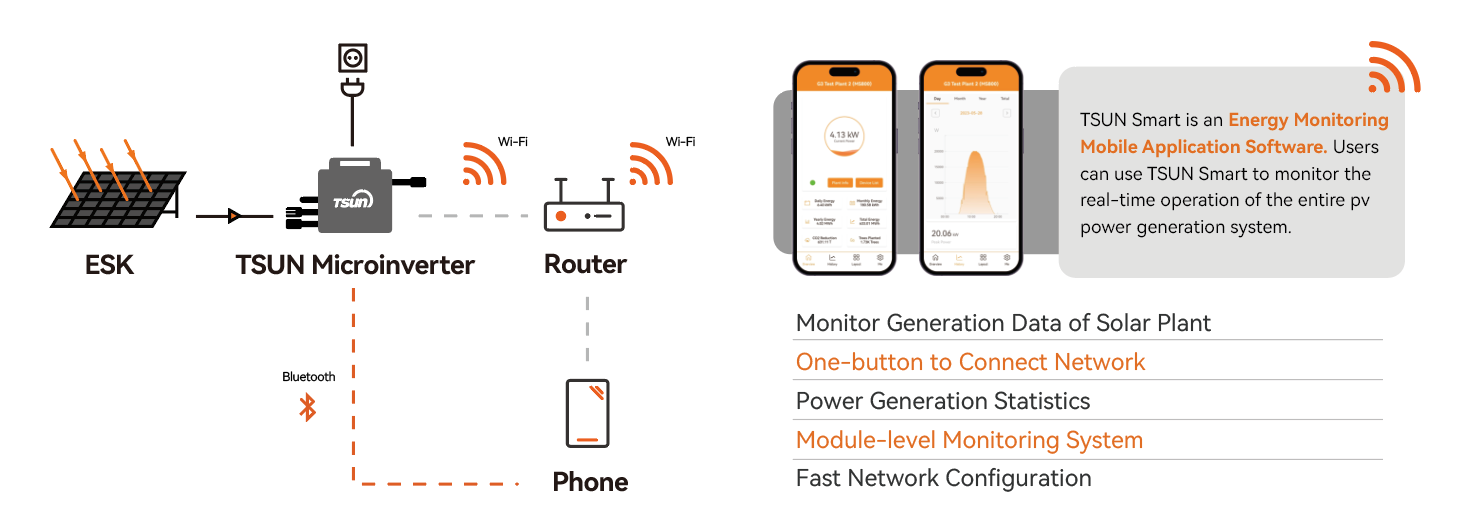
(2) Low Voltage
The microinverter uses low-voltage technology. When an electrical fault occurs, the arcs and sparks generated are smaller and the risk of injury to personnel is lower. The maximum DC input voltage of TSOL-MP3000 is 60V. In a short distance, low-voltage transmission can reduce electric energy. In addition, the system design does not need to consider withstanding high voltage conditions, and the requirements for cable size and type are not so strict, which can greatly reduce the overall system installation cost.
(3) Rapid shutdown
The microinverter has a variety of built-in safety protection functions, including overvoltage protection, overcurrent protection, short circuit protection and anti-backfeed protection. These functions ensure that the inverter can shut down safely under abnormal conditions, protecting the system and user safety. In an emergency, such as a fire or when maintenance is needed, microinverters quickly cut off the DC output of a solar panel. This feature can significantly reduce the risk for firefighters when dealing with fires associated with solar systems, as it quickly reduces the risk of arcing and electrocution. When a shutdown signal is received, the voltage of the solar panel is reduced to a safe level within a specific time (for example, within 10 seconds required by the National Electrical Code NEC).
(4) Multiple monitoring technologies
To enable remote monitoring and fault diagnosis, microinverters are often equipped with communication modules such as Wi-Fi, Zigbee or RS485. These modules allow the inverter to exchange data with a monitoring system or smart grid. Tsun is the first in the industry to launch WIFI built-in monitoring technology, which is used in TSOL-MS300~TSOL-MX1000, TSOL-MP3000 and other series of telephone products. In household scenarios, Wifi smart technology is preferred to realize intelligent monitoring conveniently and quickly, and is widely used in industrial and commercial applications. RS485 and DTU methods are used to make monitoring more stable. Tsun's WIFI technology chip adopts 105-degree automotive grade standard, with a wider temperature range and more stable monitoring.
2. How do microinverters work?
In photovoltaic power generation systems, microinverters play a vital role in converting the direct current (DC) generated by solar panels into alternating current (AC) that can be used by homes or businesses.
(1) Connection to solar panels
Each microinverter is usually connected to one or more solar panels. It is located at or near the solar panels to reduce the loss of electricity during transmission.
(2) Inverter conversion from DC to AC
Microinverters use MPPT technology to optimize the output of solar panels and adjust the operating power point of solar panels in real time to ensure maximum power output under different light and temperature conditions. Microinverters contain an inverter circuit inside that converts direct current into alternating current. This process involves high-frequency switching power supply technology to achieve efficient energy conversion.
(3) Grid connection
The converted alternating current needs to be synchronized with the frequency and phase of the power grid. Microinverters can detect the parameters of the power grid and adjust the output power to match these parameters to ensure that the power can be safely connected to the grid.
(4) Setting up monitoring
Microinverters are usually equipped with monitoring functions that can collect system data such as power generation, voltage, current, etc. in real time. These data can be sent to the monitoring center via a wireless network, and users can remotely view the system status, perform fault diagnosis and maintenance.
(5) Safety protection
The microinverter includes a variety of safety protection measures, such as overvoltage protection, overcurrent protection, short-circuit protection, etc., to ensure that the system can be safely shut down under abnormal conditions to prevent damage and accidents.
Through these steps, the microinverter ensures the effective operation of the photovoltaic system, improves the power conversion efficiency, and provides users with a safe and reliable power supply.
Tsun's Microinverter TSOL-MP3000 can achieve a single group of 64 microinverters hand in hand connection, invert the DC power generated by the solar panel to output AC power, and send it to the grid. In addition, the anti-backflow function can be realized by installing an electric meter. At the same time, the data is transmitted to the cloud through RS485 communication to achieve remote monitoring, fault diagnosis and remote maintenance.

3. Advantages of microinverters
The application advantages of microinverters in photovoltaic systems are significant, including natural low voltage safety, independent MPPT high efficiency, intelligent monitoring for easy remote control and maintenance, and flexible system scalability. Users monitor the performance of each solar panel to quickly identify and resolve issues.
(1) Safety
The microinverter uses low-voltage technology. Tsun's series of microinverter products are all 60V DC voltage, which is within the human body safety voltage standard range and is naturally safe. The conversion of DC power into AC power occurs close to the solar panel, reducing the potential fire risk of DC power being transmitted over long distances.
The built-in circuit breaker function can quickly cut off the power supply once a problem is detected to protect the system and personnel safety. The microinverter system does not generate high-voltage DC arcs, further improving the safety of the system.
(2) Efficient
The microinverter optimizes output independently for each solar panel through Maximum Power Point Tracking (MPPT) technology, ensuring each panel operates at its optimal efficiency point, thereby increasing overall system power generation. Microinverters reduce efficiency losses due to panel-to-panel variation, shading or aging because each panel operates independently and is not affected by the performance of other panels, converting more solar energy into Available electrical energy.
(3) Flexible
The modular design of microinverters makes expansion of solar systems simple. Users can gradually add solar panels and corresponding microinverters according to needs without replacing the entire system. This flexibility allows for smaller initial investments and allows users to gradually scale up the system based on future energy needs or budgets.
(4) Intelligent monitoring and maintenance
WIF, RS485 or 4G monitoring of the microinverter system enables remote monitoring and helps to quickly identify and solve problems. Users can view the performance data of each solar panel in real time, such as the performance degradation of a certain solar panel or the microinverter system. Inverter failure. Since each microinverter works independently, maintenance is simplified. If an inverter fails, only that inverter needs to be replaced without affecting the rest of the system.
4. Application scenarios of microinverters
(1) Household rooftop solar system
Microinverters are ideally suited to the residential rooftop market as they can flexibly accommodate roofs of different sizes and orientations, as well as partially shaded situations. Tsun's Microinverter TSOL-MS2000 and TSOL-MP3000 are widely used on residential roofs, providing safe and efficient photovoltaic system solutions for residential roofs.
(2) Solar energy systems for industrial and commercial buildings
The flexible scalability of microinverters makes their use on rooftops of commercial buildings significant advantages. Tsun's RS485 monitoring technology improves the stability of monitoring in industrial and commercial applications and promotes the application of microinverters in medium and large projects.
(3) Plug and play system
Plug and play is a consumer application market that has emerged in recent years. There is no need for professional installers and professional electrician skills, and consumers can DIY installation by themselves. Microinverters are ideally suited to the plug-and-play market due to their modular and simplified design. The ESK POP-UP pre-installation system designed by Tsun pre-installs and connects the TSOL-MS400 microinverter with the solar panels. Users do not need to install them. They only need to connect them to the grid to start generating electricity, which greatly lowers the installation threshold. This enables more non-professional users to install solar systems by themselves.
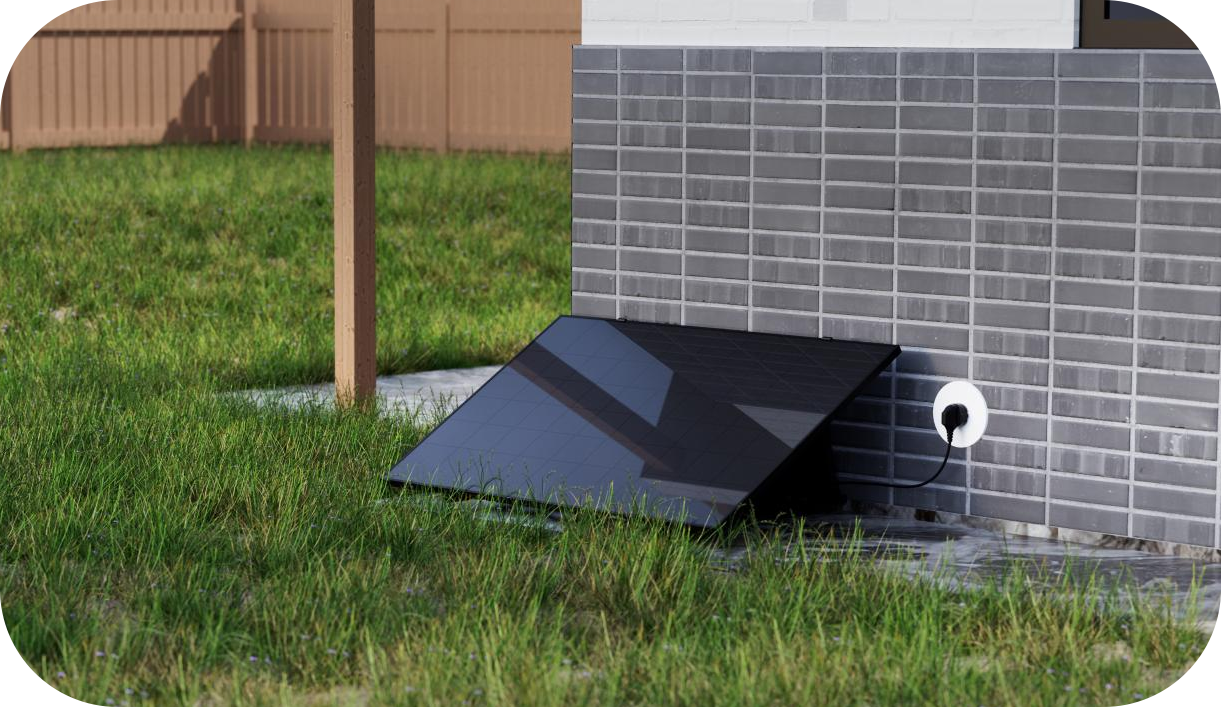
5. Comparison with string inverters
Compared with string inverters, microinverters generally perform better in terms of performance, efficiency and reliability. Although the initial cost per kilowatt-hour may be higher, the long-term maintenance costs and energy efficiency improvements often offset this difference. Microinverters are particularly suitable for installation scenarios with complex roof shapes or partial shade.
(1) Technology
Microinverter: Each microinverter is usually paired with one or several solar panels, providing independent MPPT and inversion functions. This allows each solar panel to operate at its maximum power point, improving the power generation efficiency of the overall system.
String inverter: One inverter connects multiple solar panels in series, and the entire string shares one MPPT. If the performance of a solar panel in a string deteriorates, it will affect the power generation of the entire string.
(2) Application
Microinverter: Suitable for various installation scenarios, especially for solar panel installations with complex roof shapes, partial shade or different orientations. Plug-and-play application scenarios are becoming popular in Europe.
String inverter: More suitable for large-scale, uniformly oriented and unobstructed ground installation projects.
(3) Safety
Microinverter: low voltage technology, naturally low voltage safety. In addition, since each inverter works independently, high voltage DC will not be generated in the system, reducing the risk of fire. In addition, microinverters also reduce the possibility of DC arcs and improve the safety of the system.
String inverter: The string system is up to 1500V and needs to handle high voltage DC, which has certain fire and arc risks.
(4) Cost
Microinverter: The initial investment cost is high because a separate inverter needs to be purchased for each solar panel or small string. However, the long-term operation and maintenance costs may be lower because the life cycle of microinverters is longer; Tsun's series of microinverters all use full glue filling technology to protect components from environmental pollution and increase uniform heat dissipation, making the components have a longer service life. Tsun's series of microinverters have a design life of 25 years and provide a 12-year warranty, which can be extended to 25 years.
String inverter: The initial cost is lower, but more operation and maintenance work is required. The life cycle of the string is about 10 years, but the life of the solar panel is 25 years. During the entire system life cycle, the inverter must be replaced once. In addition, when a problem occurs in the system, a single inverter is damaged, and the entire inverter may need to be replaced, and the overall operation and maintenance cost will be higher.
(5) Installation and maintenance
Microinverter: The installation is relatively simple because each inverter is independent. Maintenance is also more convenient. A problem with a single inverter will not affect the entire system, and it is easy to replace.
String inverter: Installation may require more planning and wiring work. During maintenance, if there is a problem with the inverter, the entire system may need to be shut down, affecting power generation.
6. Potential disadvantages
Potential disadvantages of microinverters: higher initial cost, challenges that may arise from installation and system complexity, and concerns about reliability and life. However, with the advancement of technology, these problems are gradually being resolved. Key factors include:
(1) Cost
The initial investment cost of a microinverter is usually higher than that of a string inverter because a separate inverter needs to be purchased for each solar panel or small string. Although long-term operation and maintenance costs may be lower, higher initial costs may hinder the choice of some consumers and project investors.
(2) Complexity
Since each solar panel needs to be connected to a separate microinverter, the installation of the system may be more complicated, especially in large-scale projects. This may require more installation time and expertise.
(3) Reliability
The number of microinverters is usually much greater than that of string inverters, so the probability of failure of any one inverter is relatively high. Although problems with a single inverter will not affect the entire system, a large number of inverters may increase the workload of maintenance.
The key factors restricting the large-scale development of microinverters are mainly cost and complexity. Tsun has insisted on developing high-power microinverters and the world's first single-phase microinverter TSOL-MP3000 to address the fundamental cost issue. It has also launched a 6000W microinverter to further reduce the cost per kilowatt-hour, which has finally solved the cost problem of microinverters.
7. Main brands and products
The leading international microinverter brand on the market is Enphase, which provides a series of products such as Enphase's IQ series and SolarEdge's Optimizer technology, which have been well received by users. In 2021, Tsun began to develop high-power microinverters and was the first to release them in 2022. It has ushered in the era of large microinverters and has become the world's No. 1 single-phase microinverter brand. Tsun has been deeply involved in the application of microinverters. In 2019, it pioneered the plug-and-play ESK series products, as well as household rooftop TSOL-MS2000 and TSOL-MP3000 series products. Among them, TSOL-MP3000 is also widely used in the industrial and commercial roof market.
8. Installation and maintenance skills
The installation and maintenance of microinverters is an important part of ensuring the efficient and reliable operation of solar photovoltaic systems. The following is a detailed introduction to the installation and maintenance of microinverters:
1.According to the design drawings, install the roof bracket and solar panels in place;
2.According to the microinverter installation manual, locate the direction of the components and choose a suitable location to install the microinverter, usually close to the solar panel to reduce cable length and energy loss;
3.Connect the components and microinverters, and all electrical connections;
4.Perform system tests, including insulation resistance tests, polarity checks, and electrical safety tests. Confirm the synchronization between the microinverter and the grid, and the normal operation of all components.
5.After the test is completed, the system can be officially started.
6.Set up monitoring, you can choose Tsun's suitable communication method WIFI, RS485, and set it according to the instructions;
Maintenance points
1.Regular inspection: Regularly check the operating status of the microinverter, the indicator light and whether there is any abnormal sound;
2.Cleaning: Regularly clean the surface of the solar panel, remove dust, leaves and other debris to ensure maximum light; clean the outside of the microinverter to avoid dust and debris affecting heat dissipation.
3.Performance monitoring: Use the built-in monitoring function of the microinverter or an external monitoring system to monitor the power generation efficiency and operating parameters of the system in real time.
4.Fault diagnosis: If the system fails, use the error code provided by the monitoring system for fault diagnosis. Troubleshoot according to Tsun's instruction manual and Tsun after-sales team when necessary.
5.Software update: Regularly check whether there is new firmware or software update to improve the performance and compatibility of the microinverter.
6.Safety check: Regularly check all electrical connections and fasteners to ensure the safety and reliability of the system.
9. Case studies and success stories
Case 1: Household rooftop solar system
Address: Germany
System size: 6kW
Inverter selection: TSUN TSOL-M350 * 15pcs
|

|
|
This family installed a 6KW solar system, but they did not want to drill holes in the roof and damage the roof surface structure. Using the Tsun TSOL-M350 microinverter and ESK Pop-UP solution, the pre-installed system can be placed directly on the flat roof to protect the roof. Each solar panel is equipped with an independent TSOL-M350 microinverter, and each solar energy can operate independently, increasing the overall system's power generation.
Through Tsun's Talent Home / Smart Home monitoring platform, the owner can view the power generation data of each solar panel in real-time to ensure that the system is always in the best working condition. Since the installation, the system has helped the owner save an average of about 25KWH daily. At 0.4 euros per kWh, it can save 10 euros per day and about 3,500 euros per year. The investment cost can be recovered in about a year. The owner is very satisfied!
|
Case 2: Industrial and commercial solar project
Location: Brazil
System size: 80kW
Inverter selection: TSUN TSOL-M1600 *52pcs microinverter
|
The Brazilian market has mandatory safety requirements for the installation of photovoltaic systems. The project uses TSUN's WeChat inverter solution, which combines two functions: fast shutdown and power optimization, to ensure that the project meets government safety regulations. Through Tsun's monitoring system, the owner can monitor the power generation in real time, and promptly identify and solve problems, thereby maximizing the return on investment.
|
|
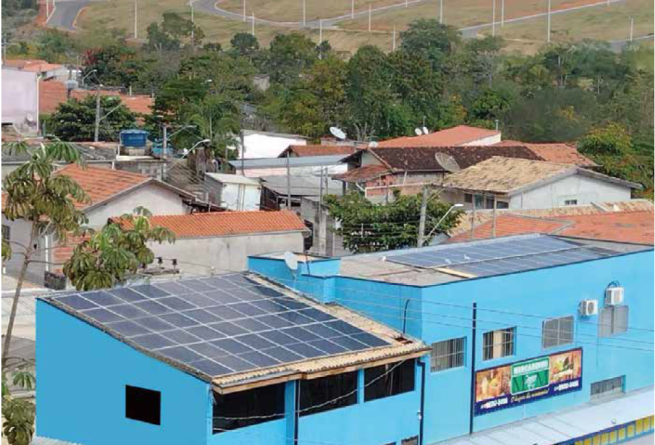 |
10. Future Trends of Microinverter Technology
(1) High-Power
As the global market's safety requirements for solar rooftop power generation systems become increasingly stringent, the application of microinverters will become particularly important. The large-scale development of microinverters has always been constrained by cost. The development of high-power microinverters can further reduce the cost per kilowatt-hour of microinverters and truly achieve large-scale popularization of microinverters. Tsun has always adhered to the development of high-power microinverter technology. After the world's first single-phase microinverter with a power of 3KW, it will launch a 6KW microinverter. This microinverter will achieve optimal cost, safety, efficiency, and easy installation. The high-power of microinverters will become inevitable.
(2) Multi-scenario
The balcony photovoltaic market with microinverters as core components is developing on a large scale and is favored by more and more end users. It has diverse application scenarios, convenient installation (can be installed by DIY), safety and reliability. microinverters have begun to enter the balconies, gardens, and fences of thousands of households, getting closer and closer to people's living areas. This also further requires the qualified specifications of microinverters, among which EMC is the test standard that all balcony system microinverters must pass. EMC testing is also a major problem that plagues the industry. It is difficult for most brands of microinverters to pass EMC testing, or it is difficult to pass the bulk test, which is limited by the electromagnetic interference of the cables on the microinverter. Therefore, how to improve the EMC pass rate of microinverters will also be a problem that each microinverter company needs to continue to solve. In 2023, Tsun was the first to pass the EMC test in the German VDE laboratory. Tsun will always adhere to the industry testing standards, lead the development of industry technology, and strive to bring plug-and-play balcony photovoltaic systems into thousands of households.
11. Conclusion
The unique advantages of safe, efficient and flexible installation of microinverters are destined to be accepted by more and more end users. As a user, when choosing a suitable microinverter, you need to consider the appropriate microinverter model, intelligence, and reliability. Choosing a high-power microinverter will effectively control the cost of the overall system, choosing one with an independent intelligent monitoring platform will make it easier to use and maintain, and choosing a microinverter with a well-known brand will guarantee long-term after-sales service;
In addition, with the diversification of scenarios, users will have higher and higher safety requirements for solar power generation systems, the microinverter industry will flourish, and more and more companies will enter the field of microinverter manufacturing. Compared with string inverters, microinverters have their own differentiated topological structures. microinverters have small power, but they are used in large numbers in system applications. They not only need to have the common characteristics of power electronics, but also pay special attention to long-life design. In power station applications, it is necessary to pay attention to the failure rate, reliability, and intelligence of microinverters. It is also necessary for all microinverter manufacturing companies to operate professionally, accumulate over a long period of time, and continuously iterate to contribute to the safe and vigorous development of the microinverter industry.
FAQs
Q: What are the advantages of microinverters compared with traditional string inverters?
A: microinverters usually have higher power generation efficiency, solve shadow shielding problems, simpler installation requirements, and smarter monitoring and maintenance capabilities.
Q: Is my residential roof suitable for installing a microinverter?
A: Microinverters have no special requirements for roofs. The more special the roof is, such as irregular roofs, the more flexible the microinverter will be to install.
Q: Is the installation process of a microinverter complicated?
A: The installation of a microinverter is relatively simple, especially for systems designed to be plug-and-play. However, to ensure safety and optimal performance, rooftop solar systems are recommended to be installed by professionals.
Q: Is the maintenance of a microinverter complicated?
A: Microinverters are usually remotely maintained through monitoring, monitoring the working performance of each component in real time, and if a failure occurs, the manufacturer will perform remote software maintenance. Regular cleaning of solar panels and checking the operating status of the inverter are the main maintenance tasks.
Q: How much electricity can a microinverter save?
A: The electricity bill saved depends on your electricity consumption, the power generation of the solar system, the local solar radiation, and the electricity price. Generally speaking, microinverters can increase the overall power generation of the solar system and save more electricity.
Q: What is the life of a microinverter?
A: Microinverters are long-life design technologies, usually up to 25 years, depending on product quality and usage conditions.
Q: Are microinverters suitable for large commercial and industrial rooftop projects?
A: Microinverters can be used in commercial and industrial rooftop projects, especially when the roof layout is complex or partially shaded. However, for very large projects, string inverters or centralized inverters may be a more economical choice.
Q: How do microinverters improve the reliability of commercial and industrial photovoltaic systems?
A: Microinverters reduce the risk of single point failures by independently managing the performance of each solar panel, thereby improving the reliability of the overall system.
Q: Can microinverters be used in conjunction with energy storage systems?
A: Yes, microinverters can be used in conjunction with energy storage systems. Tsun's DCU is a dedicated balcony microinverter system designed for existing microinverters, and it is also compatible with other brands of microinverters.
Q: What is a balcony photovoltaic system?
A: A balcony photovoltaic system is a solar power generation system installed on the balcony of a residential or commercial building, usually consisting of solar panels, microinverters and other accessories.
Q: Does a balcony photovoltaic system require maintenance?
A: Balcony photovoltaic systems are easy to maintain. They usually include cleaning the surface of the solar panels, checking the cable connections and the operating status of the microinverter.
Q: How much does a balcony photovoltaic system cost?
A: The cost of a balcony photovoltaic system depends on the size of the solar panels and the wattage of the microinverter. An 800W balcony system is equipped with two 430W solar panels, and the price for consumers is usually around 400 euros.
Q: How much electricity can a balcony photovoltaic system save?
A: An 800W balcony photovoltaic system can generate an average of 4 kWh of electricity per day in the German region, with an electricity cost of 0.4 euros/KWH, which can save 1.6 euros per day, and about 550 euros per year, and the investment cost can be recovered in one year.
 En savoir plus
En savoir plus
 En savoir plus
En savoir plus
 En savoir plus
En savoir plus
 En savoir plus
En savoir plus
 En savoir plus
En savoir plus
























 Téléchargements
Téléchargements  Centre de Vidéos
Centre de Vidéos  Signaler un problème pour réparation
Signaler un problème pour réparation  FAQS
FAQS  Réseau de Services
Réseau de Services  Politique de confidentialité
Politique de confidentialité  Contactez-nous
Contactez-nous Surveillance
Surveillance


